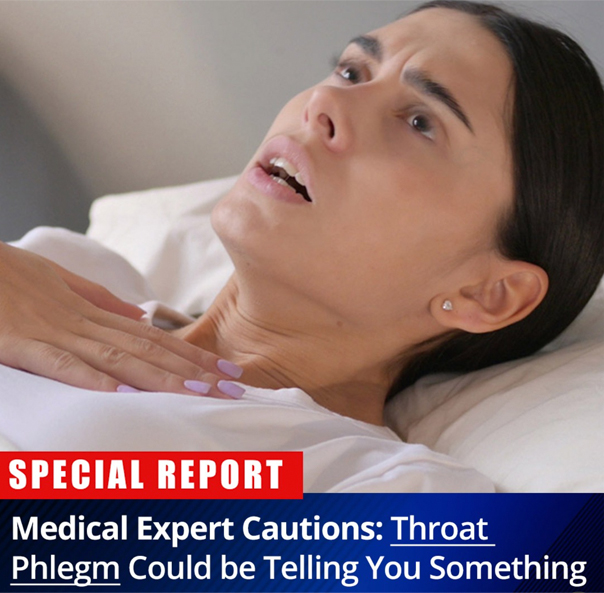Throat Cancer: Symptoms, Causes, and Treatment Options
Throat cancer is a type of head and neck cancer affecting one or more parts of the throat. Doctors typically avoid using the term “throat cancer” and instead specify the precise location with words like laryngeal or pharyngeal cancer.
This comprehensive SANE MD blog post concerning throat health, examines the prevalence, symptoms, causes, and available treatments for throat cancer. If you’re experiencing pain i.e. Adam’s Apple pain or anything that is of cause for concern, contact your primary care provider!

- New Report Says Your Brain Could Be the Key to Reducing Phlegm Over 50
- Doctor's "Leave The Throat Phlegm Behind" Tutorial Goes Viral With People Over 50
- Can You Relieve Throat Phlegm and Coughing In 60 Seconds A Day? This Doctor Says Yes
- How To Banish Phlegm When 50+ (Do This Every Day)
Key Takeaways
- Throat cancer is one of the rarer forms of cancer.
- Quitting tobacco usage, limiting alcohol consumption, and eating a healthy diet can reduce your risk of developing throat cancer.
- See your doctor if you experience throat cancer symptoms that persist for over two weeks, as early diagnosis is key to long-term survival.
Types of Throat Cancer
There are two main types of throat cancer: laryngeal and oropharyngeal.
Laryngeal cancer affects the voice box (larynx), and oropharyngeal cancer affects the part of the throat directly behind the mouth. (The term “throat cancer” most often refers to either laryngeal or oropharyngeal cancers.)
Other throat cancer types include:
- Supraglottic (upper part of larynx)
- Subglottic (lower portion of the voice box)
- Nasopharyngeal (the portion of the throat that lies directly behind the nose)
- Glottic (vocal cords)
- Hypopharyngeal (the portion of the throat just above your esophagus and windpipe
Prevalence of Throat Cancer
Even the most common types of throat cancer are rare. For example, laryngeal cancer affects only about 0.3 percent of men and women during their lifetimes, translating into an incidence of 12,380 individuals in the United States per year (1), and oropharyngeal cancer is responsible for only about 18,000 new diagnoses in the United States every year (1a).
By contrast, breast cancer accounts for 12.5% of all new cancer cases annually worldwide (2). In the U.S., an estimated 297,790 new cases of invasive breast cancer are expected to be diagnosed in 2023 (2).

Throat Cancer Symptoms
The symptoms of throat cancer can include:
- Sore throat
- Cough
- Ear pain
- Unintentional weight loss
- Difficulty swallowing
- Breathing difficulties
- Neck pain
- Vocal changes, such as hoarseness
- Headache
- A lump or lumps in the back of your throat or mouth
If any of the above symptoms last over two weeks, you must see a healthcare provider for evaluation.
Causes and Risk Factors of Throat Cancer
Throat cancer occurs when certain factors cause alterations in the genetic structure of cells in the throat. As a result of this change, previously healthy throat cells become cancerous and begin to grow and reproduce. Scientists are currently studying the causes of this transformation and have identified certain activities and medical conditions that can increase the risk of developing throat cancer, including:
- Tobacco use. Using tobacco products — cigarette smoking, chewing tobacco, snuff, etc. — for an extended period is the most significant risk factor for developing all head and neck cancers, including throat cancer.
- Excessive, regular alcohol consumption. Alcohol is a significant risk factor for throat cancers, especially if such consumption is routine and extreme. What is considered “excessive alcohol consumption?” Experts recommend that you drink no more than two alcoholic beverages if a man or more than one per day if a woman to avoid developing throat cancer.
- HPV. Cancers in the back of the throat, including the tongue and tonsils, are linked to a sexually transmitted human papillomavirus (HPV).
- Epstein Barr Virus (EBV). EBV is a common viral infection spread through saliva and bodily fluids. It can cause cancer of the nose and throat or nasopharyngeal cancer.
- Gastroesophageal reflux disease (GERD). GERD is a chronic gastrointestinal disease that makes stomach acid flow back into your esophagus.
- Diet. Research suggests that eating a diet low in fruits and vegetables may contribute to developing throat cancer.
- Age. Throat cancer is more likely to be diagnosed in those over 65.
- Gender. Adult males are at least five times more likely to develop throat cancers than females.
- Race. Studies show that African-American men are at the greatest risk of throat cancer.
- Exposure to specific chemicals. Long-term exposure to asbestos and other chemicals poses a significant risk of throat cancer.

Diagnosis
During your visit with the doctor, they will conduct an examination and inquire about your overall health, habits related to smoking and drinking, and sexual history.
They may also utilize various devices to obtain a more detailed view of your throat. If cancer is suspected, the doctor will prescribe tests and procedures based on the type of cancer they suspect.
Below are some commonly prescribed tests and procedures.
Biopsy
A biopsy is a procedure that involves collecting a tissue sample from the body to examine it under a microscope to detect any cancer cells. This is the only way to confirm if a tumor is cancerous and identify its specific type.
The procedure can be performed using surgery, fine needles, or an endoscope, a flexible tube with a camera inserted through the nose or mouth and guided to the target area. The biopsy is taken using a tool attached to the end of the endoscope.
Imaging Tests
Imaging tests can aid doctors in detecting the presence of a tumor, determining its size, and identifying whether it has spread. These tests may include:
- Magnetic Resonance Imaging (MRI) scan
- Computerized Tomography (CT) scan
- Positron Emission Tomography (PET) scan
- X-rays

Throat Cancer Stages
The staging of throat cancer varies depending on the specific type of cancer. This staging system is used to determine the severity of the disease.
In general, stages I and II indicate smaller cancers that are contained within a specific area of the organ.
Stage III cancers may have spread to nearby lymph nodes or other parts of the throat.
Stage IV cancers are the most serious and may have spread to lymph nodes and different parts of the head, neck, or chest. The most severe cases of stage IV cancer may have even spread to distant body parts, such as the lungs or liver.
Throat Cancer Treatment
To treat the most common types of throat cancer, healthcare providers employ various therapies. If you smoke or use tobacco, they may advise you to quit before undergoing surgery, chemotherapy, and radiation treatments. This can help improve the effectiveness of your treatment and reduce any adverse effects.
Doctors will aim to remove the tumor, prevent cancer from spreading, and preserve speech and swallowing abilities as much as possible. The precise treatment plan chosen will depend on the following factors:
- Throat cancer type
- Location in the throat
- Your overall health
- Patient preferences
Treatment may include one or more of the following:
- Radiation therapy. This method uses high-energy rays to kill cancer cells.
- Surgery. This procedure can be performed using a scalpel or through less invasive methods such as endoscopy, laser, or robotic techniques.
- Chemotherapy. This method uses powerful drugs to kill cancer cells and stop the disease from spreading.
- Targeted therapy. This method involves using drugs that block the substances required for cancer cells to grow, ultimately starving them.
How to Prevent Throat Cancer
There is no 100 percent guaranteed way to prevent that cancer. However, removing or reducing your risk factors can help prevent the development of throat cancer. You can reduce your risk factor by:
- Quitting tobacco usage. If you have problems quitting smoking, speak to your healthcare provider about smoking cessation programs.
- Eating a healthy diet, including lots of vegetables, fruit, and whole grains.
- Drinking only small amounts of alcohol, no more than two alcoholic beverages for a man, and no more than 1 for a woman.
- Getting the HPV vaccine to avoid specific types of HPV infection increases the risk of oropharyngeal cancer.
When to See a Doctor
If you experience any persistent new symptoms, visit your doctor. Most throat cancer symptoms are non-specific, so your doctor will likely investigate other more common causes first.
Summary
Throat cancer is a relatively rare type of cancer that only affects a small number of people annually.
Symptoms of this type of cancer can differ but may include changes in voice, difficulty swallowing, a lump on the neck, swallowing difficulties, and breathing problems. If someone experiences any of these symptoms for more than two or three weeks, it is advisable to seek medical attention from a doctor.
Frequently Asked Questions
What are the 1st signs of throat cancer?
The first signs of most throat cancers can include:
- Sore throat
- Cough
- Ear pain
- Unintentional weight loss
- Difficulty swallowing
- Breathing difficulties
- Neck pain
- Vocal changes, such as hoarseness
- Headache
- A lump or lumps in the back of your throat or mouth
If any of the symptoms mentioned above persist for two weeks or more, it is essential to consult a healthcare provider for evaluation.
Is throat cancer very curable?
Early detection of throat cancer can cure around 50% of patients, provided it hasn’t metastasized to surrounding tissues or lymph nodes in the neck.
What can be mistaken for throat cancer?
In the early stages, throat cancer can be mistaken for a cold or sore throat, with symptoms like coughing, persistent sore throat, and hoarseness.
Does throat cancer show up in blood work?
Several laboratory tests, including blood and urine tests, may be done to aid in the diagnosis and understanding of laryngeal or hypopharyngeal cancer, as no specific blood test is available.

- New Report Says Your Brain Could Be the Key to Reducing Phlegm Over 50
- Doctor's "Leave The Throat Phlegm Behind" Tutorial Goes Viral With People Over 50
- Can You Relieve Throat Phlegm and Coughing In 60 Seconds A Day? This Doctor Says Yes
- How To Banish Phlegm When 50+ (Do This Every Day)
References
1- https://seer.cancer.gov/statfacts/html/laryn.html
1a- https://www.yalemedicine.org/conditions/oropharyngeal-cancer
Dr. Matthew Olesiak, MD, is the Chief Medical Director at SANESolution, a renowned wellness technology company dedicated to providing evidence-based solutions for optimal living. Dr. Olesiak earned his medical degree from the prestigious Jagiellonian University Medical College in Kraków, Poland, where he developed a strong foundation in medicine.



